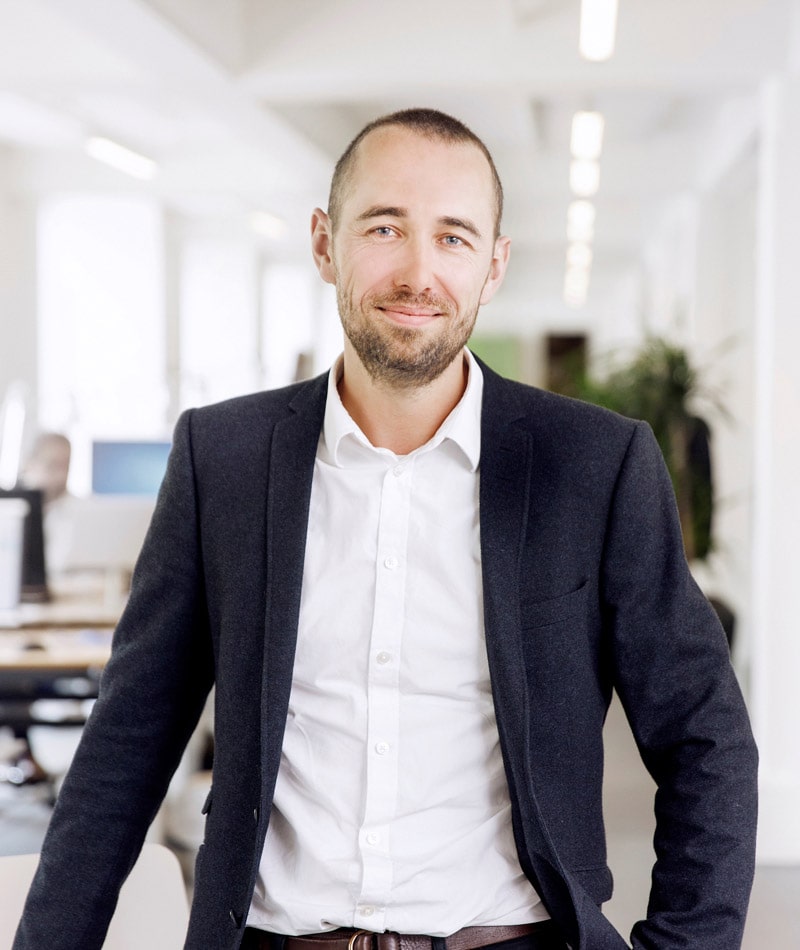Looking into soft funding always makes sense
According to Kristoffer Riis, exploring opportunities to attract soft funding always makes sense. He is a partner and CCO at Nordic Innovators, an expert in assisting companies in raising financing for their innovation projects.
“Soft funding is always something one should have an overview of. It’s a funding source that you can combine with investments or loans, and it can be an excellent source of capital to progress,” Kristoffer explains, noting that it can range from a few hundred thousand to several hundred million.
Soft funding encompasses public support, usually earmarked for research and innovation activities. It’s characterized by not requiring giving up ownership stakes or repaying the support.

When is soft funding relevant?
Financing through soft funding often revolves around timing. That’s why it’s beneficial to be aware of the opportunities continuously. Specific programs support research projects in their early stages. In contrast, others aid later development activities, pre-clinical trials, or activities where your project has matured, such as being ready to conduct clinical trials.
Kristoffer Riis mentions that timing is often a matter of the technology’s development stage, the company’s maturity, and the financing needs. In short, one must hit the right ‘sweet spot’ where the project’s stage aligns with the available support.
This ‘sweet spot’ can vary depending on the funding sought. A program like the EIC Accelerator, a popular European funding initiative targeting deep tech SMEs, might align around the Technology Readiness Level (TRL) 5-6. For pharmaceuticals, this means pre-clinical studies, animal safety, and toxicity tests have been completed, and readiness for phase 1 clinical trials. Or, for medical devices, it might mean prototypes have been demonstrated in an operational environment.
“In other European programs like ‘research & innovation actions’ or ‘innovation actions’ (RIA and IA), projects might encompass broader scopes, and thus, the ‘sweet spot’ could be at an earlier stage, like TRL 3-4. Here, the focus might be on demonstrating initial proof of concept for medical devices or drugs through in vitro and in vivo experiments or models.
Funding from programs like the EIC Pathfinder is also aimed at even earlier research stages, which lead to groundbreaking solutions.
Financing for development
According to Kristoffer Riis, consistently considering soft funding as a strategic option in your financing plan is advisable.
Soft funding is particularly relevant in stages where you are developing and testing, providing an excellent opportunity to finance necessary development costs. However, if you’re in the process of selling your product, soft funding is rarely a good option as it typically doesn’t support direct commercial activities. It serves as a funding source to assist in developing solutions and building your company.

It’s mainly in the early stages that one should consider focusing on soft funding. It should be part of your financing plan. There are opportunities, especially in the early phases of your process, where you can secure financing like half a million, which can take you a bit further. Then, you might secure 20 million next time.
Kristoffer Riis
Partner and Chief Commercial Officer, Nordic Innovators
Soft funding isn't quick money
Soft funding comes with a bureaucratic process since it involves public funds supporting your project. There’s a need to write applications, undergo evaluation, and provide ongoing reports on how the support is utilized.
Kristoffer Riis says:

It’s not quick money. Applying takes time, and there’s a period before you receive the funds. Moreover, the entire amount is typically not disbursed upfront. It often comes in installments and may even be retroactive, requiring you to have liquidity initially.
Kristoffer Riis
Partner and Chief Commercial Officer, Nordic Innovators
He continues: ‘Therefore, soft funding isn’t for everyone. However, if you’re developing something new, it’s a funding source that should be continuously considered and evaluated on par with other financing sources.’
Applying for soft funding - step by step
Kristoffer Riis mentions that depending on the support program, you should allocate anywhere from a few weeks to several months to craft your application. It can take 3-5 months or even longer before you receive a response. In collaboration with him, we’ve created a guide on how the application process unfolds.

As a first step, assess and validate the various funding opportunities. Examine the criteria for application and evaluation. Try to find information on previously funded projects to gauge your chances. Conduct due diligence and make an informed decision before diving in.
If the application requires multiple collaborators, identify and engage them in the project. Base your selection on your project idea and the funding opportunity, and find partners crucial to achieving project goals. Agree on the various roles within the project, outline necessary activities, and define the anticipated outcomes. Collaborators can include hospitals, other businesses, universities, and more.
Your application can range from five to six pages to over a hundred pages. The application serves as a project description and business plan. Allocate ample time for writing the application—ideally, at least a few months.
When you receive a response to your application, it's either a rejection or a green light. Consider whether you can reuse parts of your application for other funding programs if it's a rejection. Often, it's possible to recycle old applications. Doing so is also an opportunity to enhance your application by partnering with strong collaborators. If you receive a green light, you must finalize the contract with the funding program and partners, agreeing on a start date.
Hard funding through venture capital
Anders Kjær is the DeepTech Fund Director at PSV DeepTech and holds several relevant qualifications, including from IMD in Switzerland. He has extensive experience in investing in life science projects and venture capital.
“Venture capital is hard funding where you give up ownership in exchange for capital. Or put another way: You expand the circle of owners. The funds are used for scaling – it could be from the very early stages of technology development to much later stages focused on sales scaling – to build independent companies that can be sold or listed on the stock market multiple times within a decade,” explains Anders Kjær.

A strong chemistry between a fund and founder
“With hard funding, you exchange ownership for capital, resulting in the company having multiple stakeholders involved in its development post-investment. Therefore, having good dialogue and chemistry between founders, the CEO, and new owners is crucial,” says Anders Kjær.
“Our investment doesn’t just come in the form of injected capital; we also aim to assist in the company’s development. Before investing, we spend as much time as possible with founders to get to know them. We aim to align expectations and ambitions regarding where the company is heading and how to get there. Once we’ve invested, we hope our companies feel they have an active investor on board, someone who can and will help them with much more than just money.”
Start the dialogue early
Anders Kjær’s top advice for life science companies seeking venture capital is to start early for several reasons.
“My general advice would be to reach out very early. It’s not beneficial for your process to reach out when the funds are depleted, and it doesn’t spark interest in a potential investor if you say the coffers will be empty in three months. One should understand the venture model, and it’s okay to make an effort to comprehend it,” explains the director, elaborating further:

If you reach out early, you can build a relationship. It’s part of the process to assess the people we invest in. Relationships are built over time, so the more time you have, the better.
Anders Kjær
Anders Kjær, DeepTech Fund Director, PSV DeepTech
Make yourself noticed and earn brownie points
Life science companies work towards a term sheet, where investors have indicated their willingness to invest in the project.
At this stage, you can give yourself an advantage by making yourself known early on. Anders Kjær mentions that, for PSV DeepTech, there’s nothing too early.
“If we haven’t had the opportunity to keep up, we can’t mark a plus for the company, and then you, all else being equal, just have a handicap compared to those who have been in dialogue with us for a long time. I advise reaching out to investors even if you don’t need capital right now. Who knows, maybe you can gain some valuable information along the way.
